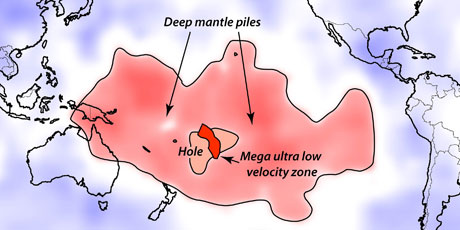A supervolcano forming north of New Zealand could spell the end of the world - but there is no need to panic, it won't happen for at least 100 million years.
Researchers from the University of Utah have warned of impending doom after discovering that two or more continent-sized piles of rock are colliding as they move at the bottom of Earth's thick mantle, 2896km beneath the
Pacific Ocean near Samoa.
They said the movement could be the beginning of a vast eruption that could threaten life on earth in 100 million to 200 million years.
"What we may be detecting is the start of one of these large eruptive events that - if it ever happens - could cause very massive destruction on Earth,'' said seismologist Michael Thorne, the study's principal author and an assistant professor of geology and geophysics at the University of Utah.
"This is the type of mechanism that may generate massive plume eruptions, but on the timescale of 100 million to 200 million years from now. So don't cancel your cruises,'' he said.
The new study is due to be published this week in the journal
Earth and Planetary Science Letters.
Massive eruptions that could be generated from the volcano "may be tied to some extinction events'', Professor Thorne said.
Researchers used the highest-resolution method yet to make seismic images of the core-mantle boundary.
Professor Thorne and his colleagues said they found evidence that where the rocks were colliding beneath a volcanically active Samoan hotspot there was a "spongy blob of partly molten rock the size of Florida, Wisconsin or Missouri''.
"The study's computer simulations show that when these (rock) piles merge together, they may trigger the earliest stages of a massive plume eruption,'' Professor Thorne said.
GNS volcanologist Steve Sherburn said the span of time that was being discussed made it difficult to pinpoint specific events.
"Presumably the article has been reviewed by the journal...to ensure it's scientifically sound.
"I guess what they're saying is this has the potential to produce a very large volcanic eruption and very large volcanic eruptions can produce global climate changing phenomena that can potentially affect life on Earth.''
How could it all end?
The two massive rocks that are colliding was creating a Florida-sized zone of partly molten rock that may be the root of either of two kinds of massive eruptions far in the future:
* hotspot plume supervolcano eruptions like those during the past 2 million years at Wyoming's
Yellowstone caldera, which covered North America with volcanic ash; or
* gargantuan flood basalt (volcanic rock) eruptions that created "large igneous provinces'' like the Pacific Northwest's
Columbia River basalts 17 million to 15 million years ago, India's
Deccan Traps some 65 million years ago and the Pacific's huge
Ontong Java Plateau basalts, which buried an Alaska-sized area 125 million to 199 million years ago.
-
APNZ















